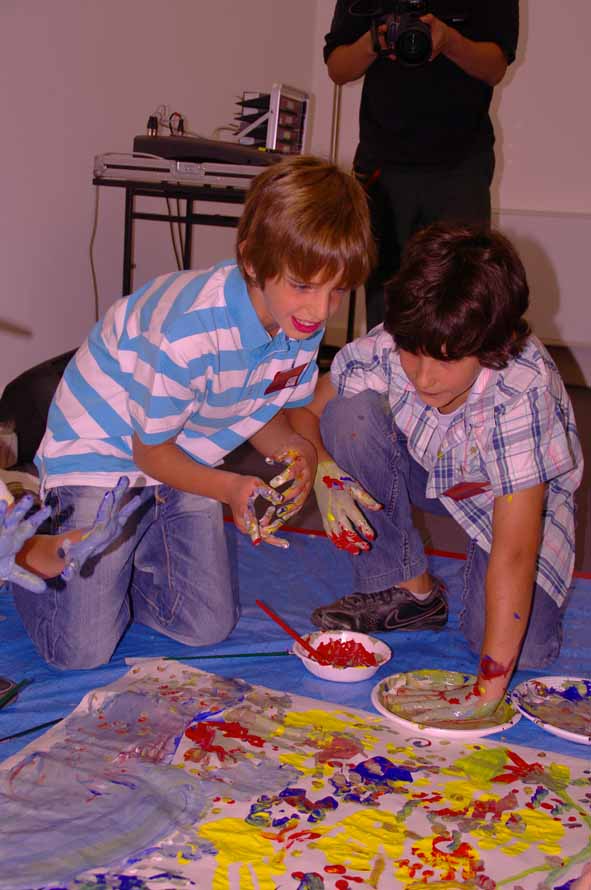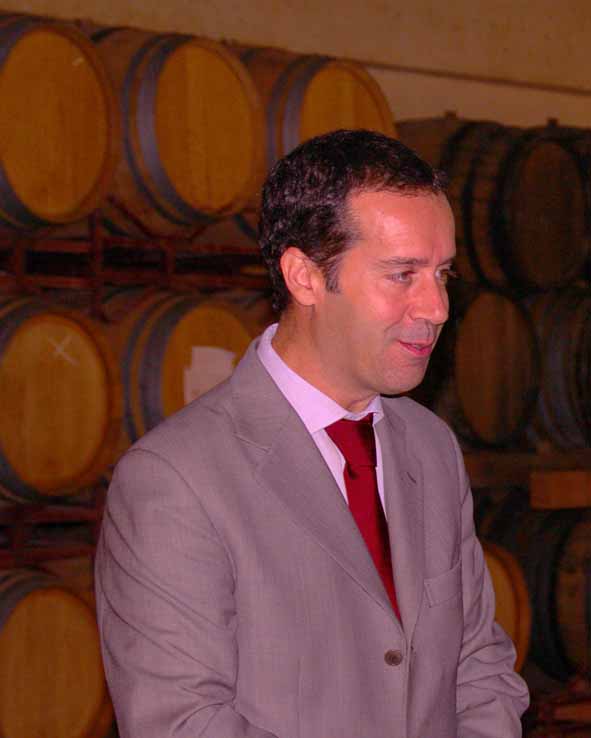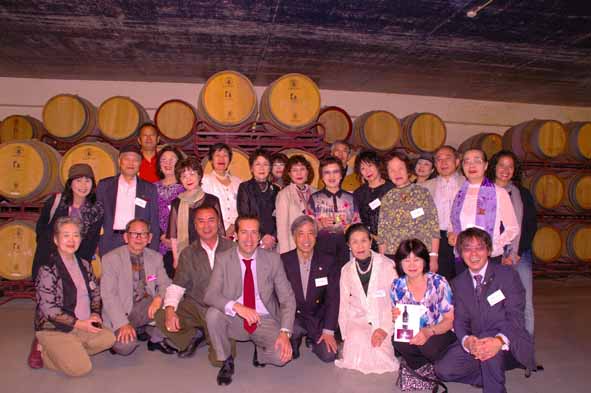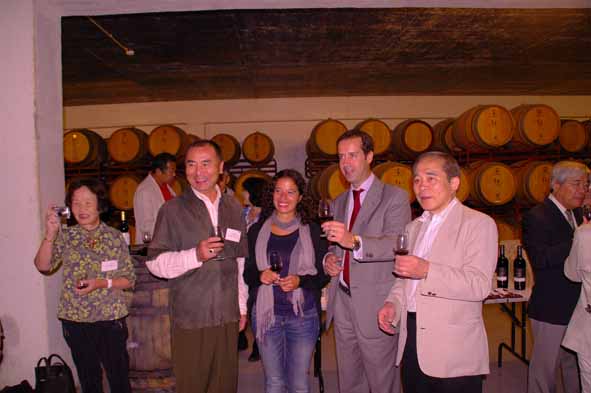Japan-Portugal : East-West Exchange of Arts and Culture
- 2010.05.26
- Activity
“Japan-Portugal: East West Exchange of Arts and Culture Exhibition” took place in Lisbon, Portugal, in October 2010. The exhibition was organized as a part of series of events commemorating the 150th anniversary of Japan-Portugal Treaty of Peace, Amity and Commerce, which were sponsored by the Ministry of Foreign Affairs of Japan.
The various artistic and cultural works by distinguished artists from all over Japan were presented for this exhibition. The exhibition was concluded in a great success, making a great contribution to cultural exchange between Japan and Portugal.
1st October (Fri) 2010
The opening ceremony of Japan-Portugal East-West Exchange of Arts and Culture was conducted at the 1st floor lounge of Orient Museum Fundação Oriente at 6:30pm.
The host of this event, Mr. Nobutoshi Akao, Senior Advisor of WAC (former Japanese Ambassador to Thailand) and 17 Japanese artists and lecturers participated in the ceremony. Mr. Joao Rodrigues Calvin, Vice President of Fundação Oriente, Ms. Maria Manuela d’Oliveira Martins, Director of the Musium, and Mr. Luis Jorge Gonçalves, Head of Art Department of National Lisbon University, were among the guests of honor for this ceremony. Mr. Fatima Ferreira, Chairman of Print Artist Association of Portugal Agua-Forte, which cooperated with WAC by displaying the works of its members, was also present. There were about 150 other guests.
Mr. Luis Jorge Gonçalves, Head of Art Department of National Lisbon University, Mr. Joao Rodrigues Calvin, Vice President of Fundação Oriente and Mr. Tatsuo Arai, Charge d’Affaires of the Japanese Embassy in Portugal, made congratulatory speeches. Then, Mr. Nobutoshi Akao made speech, representating WAC, referring to the purpose of the exhibition and expressing his gratitude to the guests for taking time to attend the opening ceremony as well as the exhibition.


Following the speeches, ceremonial sake barrel was opened and Japanese sake was served to the guests., followed by exchanges of cuisine culture, including Portugal wine tasting. Then, the certificate of display of their work was handed over to each of the Japanese and Portugese artists, who were present at the ceremony, from Ms. Martins, Director of the Orient Museum. Each artist posed for the taking of memorial photographs with Ms. Martins. The whole ceremony took place in a good and friendly atmosphere, filled with smiles and claps. Chief of Tokyo bureau of WAC handed a list of collection of works, which were presented to the Museum by Japanese artists. In response, Ms. Martins expressed her sincere gratitude.
Towards the end of the ceremony, an energetic and brilliant calligraphy performance was demonstrated by Ms. Kyogetsu Akatsuka. She calligraphed a phrase “葡萄美酒”, which means delicious wine in kanji. Ms. Martins also calligraphed some characters, taking lessons from Ms. Akatsuka. The cultural exchanges took place in a smooth and comfortable atmosphere, with the opening ceremony ending in a great success.
2nd October (Sat) 2010
The art session with children was held in Sala Toquio (Tokyo Room) of the Orient Museum at 10 a.m. Art sessions are normally conducted with purpose of cultivating social education through art, which is one of the main objectives of WAC. This time Portuguese children from a soccer school were invited to attend the session. In many countries, sport and art are like brothers and sisters and they are often treated in the same category. Therefore, we decided to invite children who play soccer.


First, Ms. Toshiko Miyazaki, who is talented at calligraphy, ink-painting and painting, explained about how the session is organized. Red, blue, yellow and white watercolors and brushes were prepared. Other colors could be made by mixing these 4 colors. Several groups of Portuguese children and Japanese artists drew on each of the big sheet of papers by themselves. Nobody knew what will be drawn on each of the papers. Some children used their brush and others used their own fingers and hands for drawing. There were no rules on how to draw. Some children were too enthusiastic and energetic with paints on their clothes but the drawings turned out to be very unique and lively. The cleaning of children’s clothes and body must not have been easy, but we felt grateful to the parents for their understanding. Memorial pictures were taken at the end of the session and the social education through art in Portugal ended in a great success.
Starting from 3 p.m. of the same day, Japanese art lessons were conducted at National Lisbon University. The lecturers consisted of 3 calligraphers and 4 craftsmen from Japan. More than 20 students attended each lesson, lasting for 3 hours in 7 classrooms.
The students listened very carefully to each of the lecturers and participated in the demonstration. 3 hours passed by like a flash. It was very interesting to see Mr. Luis Jorge Gonçalves, Head of Art Department of the University, also attending the lessons and listening attentively to the lecturers.
Speeches by guests of honor and from the host of this exhibition
・Mr. Luis Jorge Gonçalves: Head of Art Department of National Lisbon University

I attach a great importance to the friendly relations between Portugal and Japan,which are being cultivated through art and culture. Both countries met around 450 years ago for the first time, but there was a long period of time when our relationship was rather remote. However, recently our relationship has become tighter again and I could say that we have met once again. It has already been 150 years since the reunion.
Since Portugal, which is located on the far west, and Japan, which is located on the far east of the old world, met each other for the first time, exchanges of art and culture have been taking place. I think that this is very interesting fact and also very meaningful. I am very happy to be able to join this wonderful exhibition today.
・Mr. Joao Rodrigues Calvin: Vice President of Fundação Oriente

I think international exchange of art is very meaningful, helping further development of culture of each country. I would like to especially thank the Japanese artists who have shared the purpose of this event and have donated their works. The collection of our museum will become more enriched with your works.
I hope that this type of east and west cultural exchange events would be more frequently organized and develop stronger and closer bond of friendship. I would like to thank everyone here on behalf of the Fundação Oriente.
・Mr. Tatsuo Arai: Charge d’Affaires of Japanese Embassy in Portugal

Nowadays, the Portuguese people have increasingly frequent opportunities to experience various Japanese cultures, including Japanese cuisine. Sushi is very popular in Portugal and, of course, we cannot ignore the influence of Japanese animation and manga. I hope that the Japanese artists and Portuguese artists who have established contact through this event would continue such exchanges in future as well, contributing further deepening of relations between Japan and Putugal..
・Mr. Toshinobu Akao: Senior Advisor of WAC:

WAC was established with purpose of deepening mutual understanding and developing trust through arts and culture in a world filled with different cultures and ethnic groups. We have promoted activities for exchanging arts and culture among countries such as Japan, ASEAN countries and European countries. This year we celebrate the 10th anniversary for WAC and also the 150th anniversary of Japan-Portugal diplomatic relations. It is a great pleasure and honor for us to be able to organize our exhibition in such a memorable year.
Although Japan and Portugal are respectively located on the far east and far west of the old world, we have a long history of 450 years of trade and friendship. I am confident that events celebrating the 150th anniversary will further deepen the mutual understanding and interaction between both countries.
I would also like to express my gratitude to members of Japanese Embassy, Fundação Oriente and Art Department of National Lisbon University. I would also like to thank the members of Print Artist Association of Portugal who have joined this exhibition.
4th October (Mon) 2010
Chevalier of Art Wine Installation Ceremony was conducted at SOTA Winery from 10 a.m.
The ceremony began with an opening speech by Mr. Nuno Carvalho, President of SOTA. Then a speech by Mr. Nobutoshi Akao, Senior Advisor of WAC, expressing his gratitude, followed by awarding of 11 acknowledged artists with Chevalier of Art Wine badge and installation certificate. Then, a wine tasting event was held by the Chevaliers.
・Speech by Mr. Nuno Carvalho, President of SOTA Winery

I would like to thank all the Japanese artists for coming to this winery not only to taste our wine, but also to cooperate with us in the making of wine labels. It is a great honor and pride for us to conduct the Chevalier of Art Wine Installation Ceremony and at the same time I feel a little bit flattered.
This year is the 150th anniversary for Japan- Portugal relationship and, at the same time, the 150th anniversary for our family to have acquired the vineyard of Damasceno. It is 10 years since the Damasceno wine was born and I just heard that it is also 10 years since WAC started its activities of international cultural exchange. We export our wine to 10 countries not just in Europe but also in Asia. What is interesting is that the first country to which we exported our wine was Japan.
Portugal and Japan share the history of meeting with each other for the first time as the countries representing the far west and the far east of the old world and I notice a strange coincident with the history in what has happened to our business.
Wine is said to be art works of drinking. I hope that wine will help further enhance the artists’ creativeness.
・Speech by Mr. Nobutoshi Akao, Senior Advisor of WAC
We just heard that Japan was the first country to which SOTA exported its wine, but I also heard that there is more between SOTA and Japan. I used to live in Thailand as Japanese ambassador and the uncle of President used to live in Thailand as a diplomat and later in the 1990’s in Japan as Cultural Attache of the Portuguese Embassy in Tokyo. It tells us that the family of President of SOTA has a long history of relationship with Japan.
I want briefly to talk about the relationship between wine and art. I lived in Europe for 5 years 1990’s and I learned that the vintage wine of Chateaux Mouton Rothschild, one of the five most famous chateaux of Bordeaux, has been known for using paintings by different artists every year for its labels. Since 1945, paintings of famous artists such as Georges Braque, Salvador Dali, Joan Miro, Marc Chagall, Hisao Domoto, Pablo Picasso, Andy Warhol, Keith Haring, Balthus etc have appeared on its labels.
I just heard that it is the first time for SOTA Winery to use labels of art on its bottles. I hope this project would provide an opportunity to further deepen the mututal understanding between SOTA Winery and Japanese artists as well as relationship between Portugal and Japan.


Location : Orient Museum (Fundação Oriente)
Schedule : 1st ~ 10th October 2010
Host : World Art and culture exchange in Tokyo
Sponsor : Embassy of Japan in Portugal
Embassy of Portugal in Japan
Japan – Portugal Association
Cooperation: Fundação Oriente
National Lisbon University
SOTA Winery




